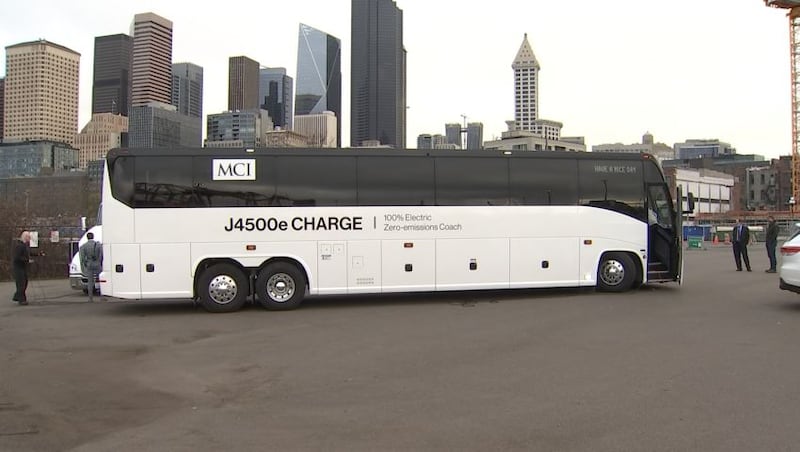SEATTLE — The future may be electric vehicles, but what is it going to take to make that happen?
Officials from the Ports of Seattle and Tacoma, Build Back Black Washington, Starline Luxury Coaches and Clean & Prosperous Washington spoke about ways to decarbonize Washington’s transportation system at an event on Seattle’s waterfront Tuesday morning.
Whether it’s trucks, buses or boats, Michael Mann, executive director of Clean and Prosperous Washington, would like to see emissions traded out for electric power.
An electric motor coach and an all-electric Kenworth semitruck at the event showed it can be done, but it will take effort.
“These bigger vehicles require bigger batteries so they’re a bigger challenge,” said Mann. “Just like we made incentives to change to LED bulbs, we can have incentives to electrify our transportation system. The state Legislature is trying to figure out how to spend $5.2 billion that we raise from carbon pollution revenues and fees, and this is a very good way for them to spend this money.”
The semitruck rolled in with stealthy silence, without a rumbling engine or belching smoke.
It can go 150 miles on a charge and Kenworth said it could transform local and regional trucking.
“it’s incredibly quiet — you hear some of the air systems kick in,” said Sean Henebry with Kenworth Trucks. “For the driver it’s a much quieter ride. It’s smooth, there’s less vibration. At the end of the day, (when) they’re driving this around, they don’t have the same driver fatigue that they might have in the past.”
An electric camper and bus also proved to be silent, more proof that larger vehicles can go electric.
Paula Sardinas, President of the Build Back Black Alliance, said her college commutes often came with exposure to emissions.
“In order to become educated and to have a better future I was literally killing myself,” said Sardinas. “I didn’t have a car, so the only way that I could get to work in college was public transit.”
She said her story is similar to many others in minority communities, so she’s thrilled to see a future with vehicles that could help Washington breathe easier.
“Our children had respiratory illness. They had asthma. They were being born with childhood cancer. We needed change and we needed it now,” said Sardinas.
Meanwhile, Washington State Ferries expects its first electric ferry to come into service in 2025. Governor Jay Inslee wants a zero-emission fleet across the ferry system.
More news from KIRO 7
- Surveillance video captures alarming Belltown baseball bat attack
- She wrote ‘help’ in her own blood. Ex-husband sentenced for gruesome Bonney Lake stabbing
- One dead, one injured after shooting inside Richland Fred Meyer; warrant issued for suspect
- Do you have an investigative story tip? Send us an email at investigate@kiro7.com
©2022 Cox Media Group








